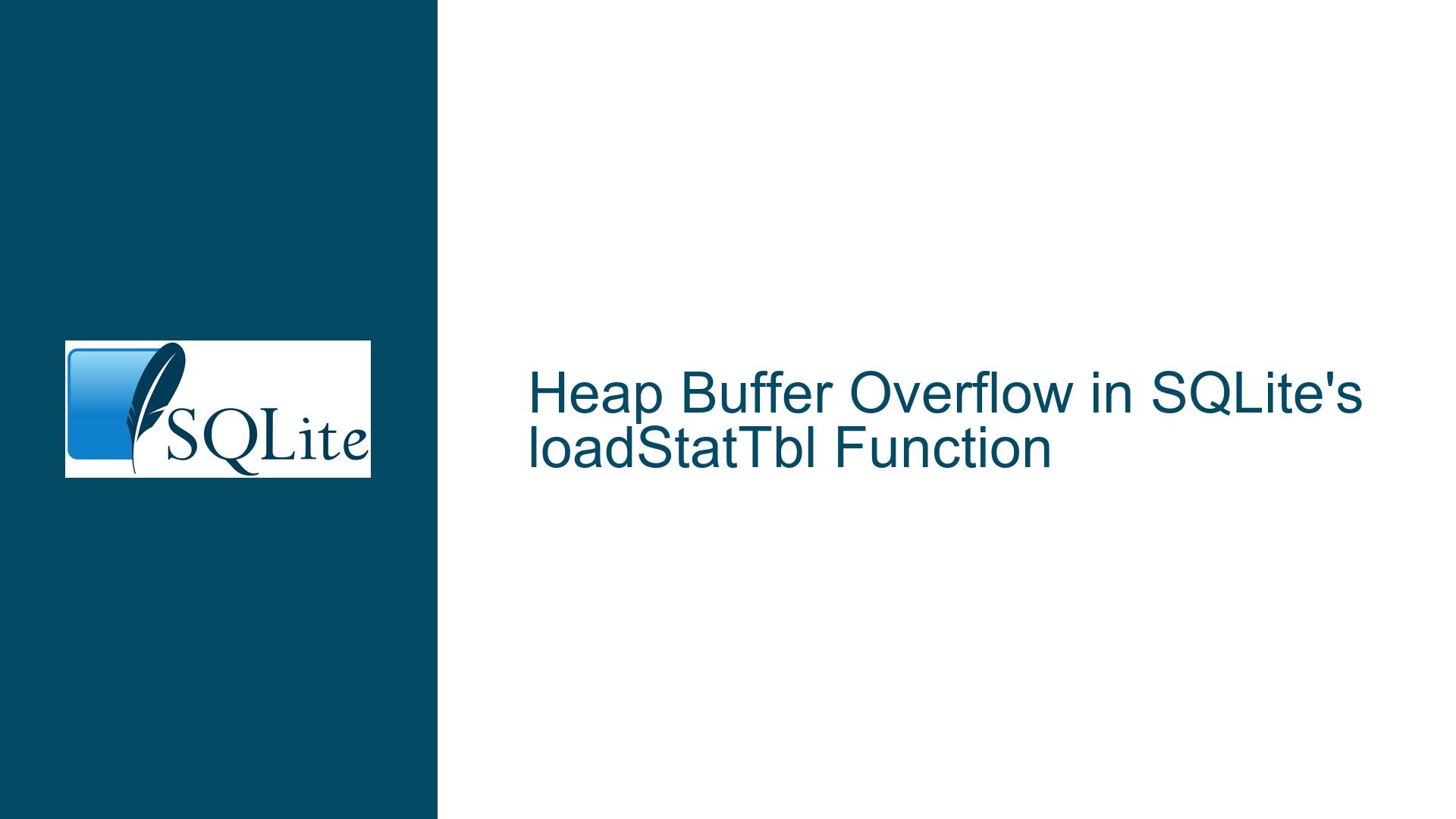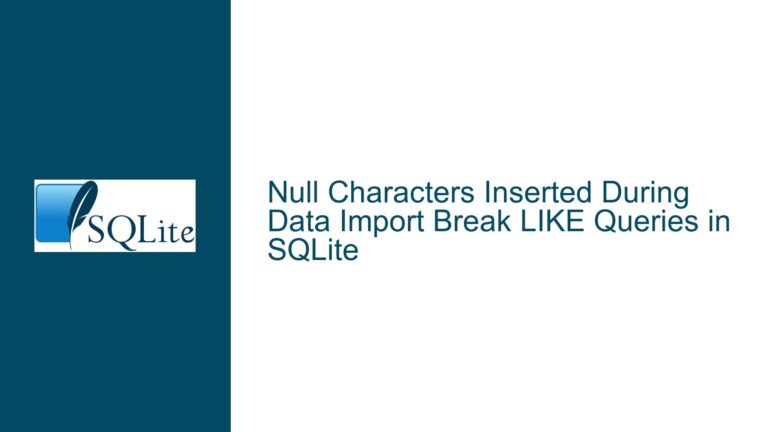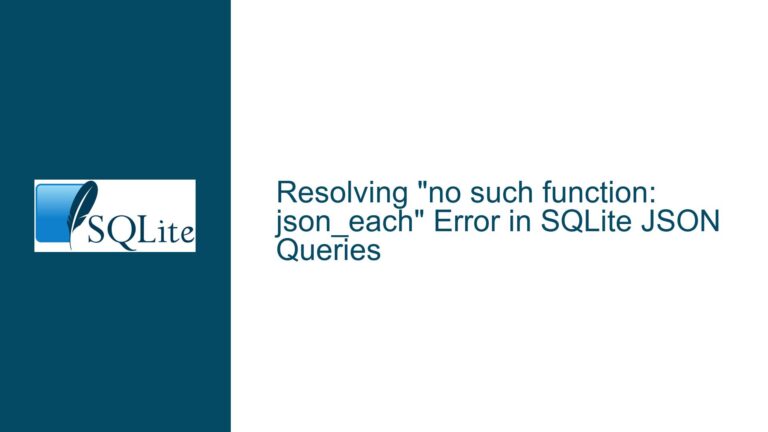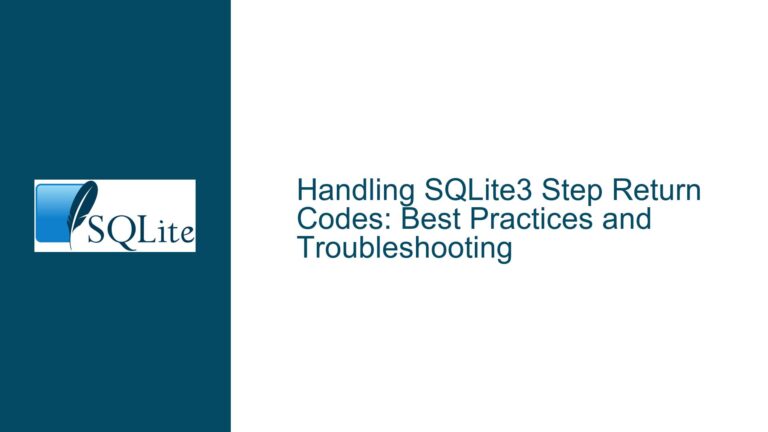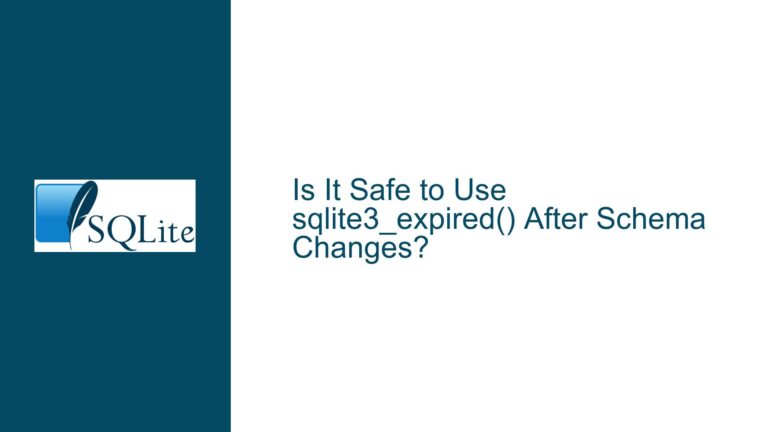Heap Buffer Overflow in SQLite’s loadStatTbl Function
Heap Buffer Overflow in SQLite’s loadStatTbl Function: A Deep Dive
Issue Overview
The core issue at hand is a heap buffer overflow occurring in the loadStatTbl function within SQLite. This overflow is triggered when executing a specific sequence of SQL queries, particularly involving the creation of a trigger. The overflow manifests as a memory corruption issue, leading to a crash that is detected by AddressSanitizer (ASAN). The ASAN report indicates that the overflow occurs when attempting to read 8 bytes from a memory address that is located just beyond the end of a 72-byte allocated region. This suggests that the function is accessing memory outside the bounds of what was allocated, which is a classic symptom of a buffer overflow.
The loadStatTbl function is part of SQLite’s internal mechanism for loading statistical data about tables and indexes, which is used by the query planner to optimize query execution. The function is called during the initialization phase of the database, specifically when SQLite is loading the schema and preparing to execute queries. The overflow occurs in a context where SQLite is attempting to load statistical data for a table, but due to an error in memory allocation or pointer arithmetic, it ends up reading beyond the allocated memory region.
The specific sequence of SQL queries that triggers this issue involves opening a database file (malform) and executing a CREATE TRIGGER statement. The trigger creation process involves several steps, including parsing the SQL statement, locating the table on which the trigger is to be created, and loading statistical data about the table. It is during this last step that the heap buffer overflow occurs.
The ASAN report provides a detailed stack trace, showing the sequence of function calls that lead to the overflow. The trace starts with the shell_exec function, which is responsible for executing SQL commands in the SQLite shell, and proceeds through several layers of SQLite’s internal functions, including sqlite3Prepare, sqlite3RunParser, and sqlite3BeginTrigger, before finally reaching loadStatTbl. The report also indicates that the memory region involved in the overflow was allocated by the sqlite3MemMalloc function, which is SQLite’s internal memory allocator.
Possible Causes
The heap buffer overflow in loadStatTbl could be caused by several factors, each of which needs to be carefully examined to determine the root cause of the issue. One possible cause is an error in the memory allocation logic within loadStatTbl. The function may be allocating insufficient memory for the statistical data it needs to load, leading to an overflow when it attempts to access memory beyond the allocated region. This could be due to a miscalculation in the size of the memory block needed, or it could be the result of an off-by-one error in the allocation logic.
Another possible cause is an error in the pointer arithmetic used by loadStatTbl to access the statistical data. The function may be incorrectly calculating the address of the data it needs to read, causing it to access memory outside the bounds of the allocated region. This could be due to a bug in the code that calculates the offsets for accessing different parts of the statistical data, or it could be the result of an incorrect assumption about the layout of the data in memory.
A third possible cause is an issue with the data being loaded by loadStatTbl. The function may be attempting to load corrupted or malformed statistical data, which could cause it to access memory outside the bounds of the allocated region. This could be due to a bug in the code that generates or stores the statistical data, or it could be the result of an external factor, such as a corrupted database file.
The compilation flags used to build SQLite may also play a role in this issue. The flags include several debugging and optimization options, such as -DSQLITE_DEBUG, -DSQLITE_ENABLE_STAT4, and -DSQLITE_ENABLE_TREETRACE. These flags enable additional features and debugging information in SQLite, which could potentially expose or exacerbate issues in the code. For example, the -DSQLITE_ENABLE_STAT4 flag enables the use of statistical data for query optimization, which is directly related to the loadStatTbl function. If there is a bug in the code that handles this statistical data, enabling this flag could increase the likelihood of encountering the heap buffer overflow.
Troubleshooting Steps, Solutions & Fixes
To troubleshoot and resolve the heap buffer overflow in loadStatTbl, a systematic approach is required. The first step is to reproduce the issue in a controlled environment. This involves using the provided malform database file and executing the sequence of SQL queries that trigger the overflow. The ASAN report provides valuable information about the memory addresses involved in the overflow, as well as the sequence of function calls that lead to the issue. This information can be used to set breakpoints in a debugger and step through the code to identify the exact point where the overflow occurs.
Once the issue has been reproduced, the next step is to examine the memory allocation and pointer arithmetic in loadStatTbl. This involves reviewing the code that allocates memory for the statistical data and the code that calculates the addresses for accessing this data. Special attention should be paid to any calculations involving the size of the memory block or the offsets used to access different parts of the data. Any discrepancies or potential sources of error should be noted and investigated further.
If the issue is found to be related to memory allocation, the solution may involve adjusting the size of the memory block allocated by loadStatTbl. This could involve increasing the size of the block to ensure that it is large enough to hold all the statistical data that needs to be loaded. Alternatively, the solution may involve modifying the code that calculates the size of the block to ensure that it accurately reflects the amount of data that will be loaded.
If the issue is related to pointer arithmetic, the solution may involve correcting the calculations used to determine the addresses of the statistical data. This could involve revising the code that calculates the offsets for accessing different parts of the data, or it could involve adding additional checks to ensure that the calculated addresses are within the bounds of the allocated memory region.
If the issue is related to corrupted or malformed statistical data, the solution may involve adding additional validation checks to ensure that the data being loaded is in the correct format and does not contain any errors. This could involve adding checks to verify the integrity of the data before it is loaded, or it could involve modifying the code that generates or stores the data to ensure that it is always in a valid state.
In addition to these code-level fixes, it may also be necessary to review the compilation flags used to build SQLite. If certain flags are found to exacerbate the issue, they may need to be disabled or modified. For example, if the -DSQLITE_ENABLE_STAT4 flag is found to increase the likelihood of encountering the heap buffer overflow, it may be necessary to disable this flag or modify the code that handles statistical data to ensure that it is more robust.
Finally, it is important to thoroughly test any changes made to the code to ensure that they resolve the issue without introducing new problems. This involves running the modified code through a series of tests, including the original sequence of SQL queries that triggered the overflow, as well as additional tests to verify that the changes have not introduced any regressions. The ASAN report can be used to verify that the heap buffer overflow no longer occurs, and additional debugging tools can be used to ensure that the code is functioning as expected.
In conclusion, the heap buffer overflow in SQLite’s loadStatTbl function is a complex issue that requires a thorough understanding of the code and the underlying memory management mechanisms. By carefully examining the memory allocation and pointer arithmetic in loadStatTbl, and by considering the impact of the compilation flags used to build SQLite, it is possible to identify and resolve the root cause of the issue. With the right approach, this issue can be fixed, ensuring that SQLite remains a reliable and robust database engine.
